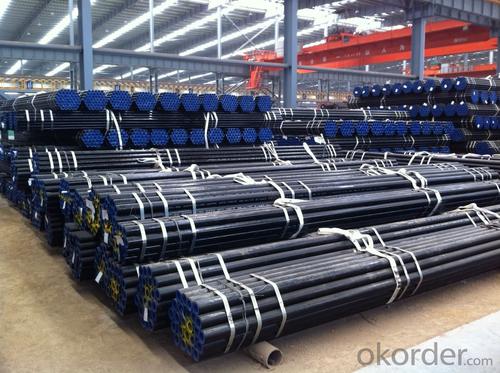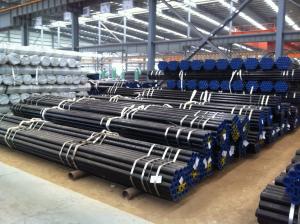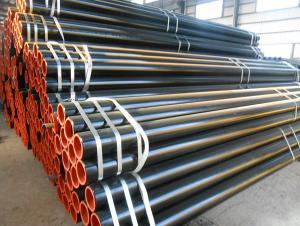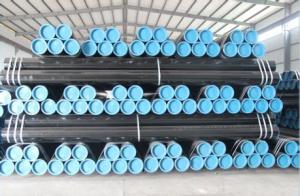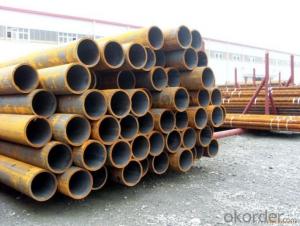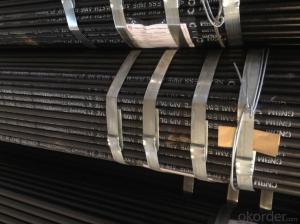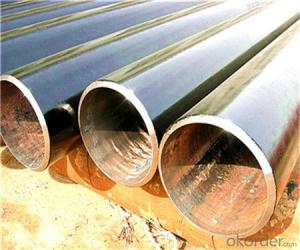API 5L Seamless Carbon Steel Pipe for 6 Inch Hot Sales
- Loading Port:
- Tianjin
- Payment Terms:
- TT OR LC
- Min Order Qty:
- 25 m.t.
- Supply Capability:
- 1000 m.t./month
OKorder Service Pledge
OKorder Financial Service
You Might Also Like
Product Description:
1、Structure of API 5L Seamless Carbon Steel Pipe for 6 Inch Hot Sales:
Seamless pipe is formed by drawing a solid billet over a piercing rod to create the hollow shell. As the manufacturing process does not include any welding, seamless pipes are perceived to be stronger and more reliable. Historically seamless pipe was regarded as withstanding pressure better than other types, and was often more easily available than welded pipe.
2、Main Features of API 5L Seamless Carbon Steel Pipe for 6 Inch Hot Sales:
• High manufacturing accuracy
• High strength
• Small inertia resistance
• Strong heat dissipation ability
• Good visual effect
• Reasonable price
3、API 5L Seamless Carbon Steel Pipe for 6 Inch Hot Sales Images:
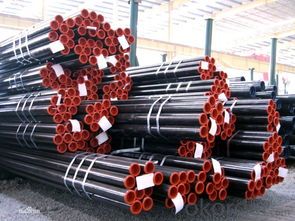
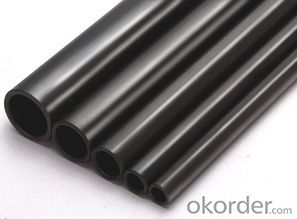
Packaging & Delivery
Packaging Details: | seaworthy package,bundles wrapped with strong steel strip |
Delivery Detail: | 15-30days after received 30%TT |
4、API 5L Seamless Carbon Steel Pipe for 6 Inch Hot Sales Specification:
Standard | GB, DIN, ASTM |
Grade | 10#-45#, 16Mn |
Thickness | 8 - 33 mm |
Section Shape | Round |
Outer Diameter | 133 - 219 mm |
Place of Origin | Shandong, China (Mainland) |
Secondary Or Not | Non-secondary |
Application | Hydraulic Pipe |
Technique | Cold Drawn |
Certification | API |
Surface Treatment | factory state or painted black |
Special Pipe | API Pipe |
Alloy Or Not | Non-alloy |
Length | 5-12M |
Outer Diameter | 21.3-610mm |
Grade | 20#, 45#, Q345, API J55, API K55, API L80, API N80, API P110, A53B |
Standard | ASME, ASTM |
1.Material:20#(ASTM A 106/A53 GRB.API5LGRB,GB),45#,16Mn,10#.
2.Specification range:OD:21.3-610mm,WT:6-70mm,length:6-12m or according to the requirement of clients.
3.Excutive standards:GB,ASME API5L.ASTM A 106/A53,Despite of the above standards,we can also supply seamless steel pipe with standard of DIN,JIS,and so on,and also develop new products according to the requirements of our clients!
4.Surface:black lacquered,varnish coating or galvanized.
5.Ends:Beveled or square cut,plastic capped,painted.
6.Packing:bundles wrapped with strong steel strip,seaworthy packing.
5、FAQ ofAPI 5L Seamless Carbon Steel Pipe for 6 Inch Hot Sales:
①How is the quality of your products?
Our products are manufactured strictly according to national and internaional standard, and we take a test
on every pipe before delivered out. If you want see our quality certifications and all kinds of testing report, please just ask us for it.
Guaranteed: If products’ quality don’t accord to discription as we give or the promise before you place order, we promise 100% refund.
②How about price?
Yes, we are factory and be able to give you lowest price below market one, and we have a policy that “ for saving time and absolutely honest business attitude, we quote as lowest as possible for any customer, and discount can be given according to quantity”,if you like bargain and factory price is not low enough as you think, just don’t waste your time.Please trust the quotation we would give you, it is professional one.
③Why should you chose us?
Chose happens because of quality, then price, We can give you both.Additionally, we can also offer professional products inquiry, products knowledge train(for agents), smooth goods delivery, exellent customer solution proposals.Our service formula: good quality+good price+good service=customer’s trust
SGS test is available, customer inspection before shipping is welcome, third party inspection is no problem.
Any question, pls feel free to contact us !
- Q: What are the specific differences between flexible pipes and rigid pipes?
- Watch from outside:The rigid waterproof sleeve is made up of steel bushing and wing ring, and the structure is simple;The flexible waterproof sleeve mainly consists of flange sleeve, sealing ring, flange, pressure plate, wing ring, bolt and nut. The structure is complicated.
- Q: What's the difference between a cracked carbon steel tube and a liquid carbon steel tube?
- If the material is the same, the process is different from the test.
- Q: How are steel pipes handled and transported safely?
- Steel pipes are handled and transported safely by following certain procedures. They are usually lifted and moved using cranes or forklifts that have the appropriate capacity to handle their weight. To prevent damage during transportation, pipes are secured in sturdy containers or bundles, often by using straps or chains. In some cases, protective coverings or caps are used to shield the ends from any potential damage. Additionally, proper stacking techniques are employed to ensure stability and prevent accidents during transportation.
- Q: How to distinguish between steel pipe and spiral pipe material?
- Steel pipe according to the pipe material (ie steel) can be divided into: carbon tube and alloy tube, stainless steel tube.Carbon tube can be divided into ordinary carbon steel tube and high quality carbon structure tube.
- Q: Can steel pipes be used for underground heat exchange systems?
- Underground heat exchange systems can utilize steel pipes, which are known for their durability and strength against the pressure and environmental conditions underground. Steel is resistant to corrosion and can withstand high temperatures, allowing for efficient heat transport. Moreover, steel pipes are readily accessible and cost-effective compared to other materials, which contributes to their widespread use in underground heat exchange systems. Nevertheless, it is crucial to appropriately insulate and safeguard the steel pipes to prevent heat loss and potential harm caused by external elements like moisture or soil displacement.
- Q: Can steel pipes be used for sewage and wastewater systems?
- Yes, steel pipes can be used for sewage and wastewater systems. Steel pipes are highly durable, resistant to corrosion, and can withstand high pressure and temperature conditions, making them suitable for transporting sewage and wastewater efficiently and securely. Additionally, steel pipes have a long lifespan and can handle the abrasive nature of sewage and wastewater, making them a reliable choice for such systems.
- Q: How are steel pipes used in plumbing?
- Steel pipes are commonly used in plumbing applications due to their durability, strength, and resistance to corrosion. They are used to transport water, gas, and other fluids from one place to another in a plumbing system. Steel pipes are often found in underground water supply networks, as well as in buildings for conveying hot and cold water, drainage, and venting systems. Additionally, steel pipes are also utilized for connecting fixtures, such as sinks, showers, toilets, and appliances, ensuring a reliable and long-lasting plumbing infrastructure.
- Q: How do you measure the thickness of steel pipes?
- To measure the thickness of steel pipes, you can use various methods depending on the level of accuracy required. One commonly used method is the ultrasonic measurement technique. Ultrasonic measurement involves using an ultrasonic thickness gauge, which emits high-frequency sound waves that travel through the pipe walls and bounce back to the gauge. The time it takes for the sound waves to travel through the pipe and return provides an accurate measurement of the thickness. This method is non-destructive and can be used on both ferrous and non-ferrous materials. Another method is the use of calipers or micrometers. This involves manually measuring the outside diameter (OD) and inside diameter (ID) of the pipe and then subtracting the ID from the OD to obtain the thickness. However, this method is less accurate compared to ultrasonic measurement. In some cases, where precision is not critical, a simple tape measure or ruler can be used to measure the outside diameter of the pipe. The thickness can then be estimated by referring to standard pipe thickness charts or tables. It is important to note that measuring the thickness of steel pipes accurately is crucial for various applications such as construction, manufacturing, and engineering. Therefore, it is recommended to use appropriate measuring tools and techniques to ensure accurate results.
- Q: How does galvanization protect steel pipes from corrosion?
- Galvanization protects steel pipes from corrosion by applying a protective zinc coating on the surface of the pipes. This zinc coating acts as a sacrificial anode, meaning it corrodes first before the steel, effectively preventing rust and corrosion from reaching the underlying steel.
- Q: What is the difference between steel pipe and concrete pipe?
- Steel pipe and concrete pipe are commonly used for various applications, but they have significant differences in material composition and properties. To begin with, the primary distinction lies in the materials utilized to manufacture these pipes. Steel pipes consist of steel, an alloy of iron and carbon. Conversely, concrete pipes are composed of a mixture of cement, aggregate (such as sand or gravel), and water. Additionally, steel pipes are renowned for their strength and durability. They can withstand high pressure, making them suitable for transporting fluids or gases under high pressure. Steel pipes also possess high resistance to corrosion, which is advantageous in environments exposed to moisture or chemicals. In contrast, concrete pipes are not as sturdy as steel pipes and are more prone to cracking or damage under high pressure. Nevertheless, they can still handle moderate pressure loads and are often employed in drainage systems or sewage applications. Another noteworthy difference is the installation process. Steel pipes are typically joined together through welding techniques like butt welding or socket welding, creating a seamless and robust connection between the pipes. Conversely, concrete pipes are often installed using rubber or gasketed joints, which are simpler to assemble and disassemble. Cost is another factor where steel and concrete pipes diverge. Steel pipes tend to be more expensive due to the higher cost of steel as a raw material and the additional labor required for welding and fabrication. On the other hand, concrete pipes are generally more cost-effective as the materials used in their production are more readily available and the installation process is simpler. In summary, the main disparities between steel pipes and concrete pipes revolve around their material composition, strength, resistance to corrosion, installation process, and cost. Steel pipes offer superior strength and durability, making them suitable for high-pressure applications and environments prone to corrosion. Concrete pipes, while not as robust, are cost-effective and commonly used in drainage systems or sewage applications.
Send your message to us
API 5L Seamless Carbon Steel Pipe for 6 Inch Hot Sales
- Loading Port:
- Tianjin
- Payment Terms:
- TT OR LC
- Min Order Qty:
- 25 m.t.
- Supply Capability:
- 1000 m.t./month
OKorder Service Pledge
OKorder Financial Service
Similar products
Hot products
Hot Searches
Related keywords


